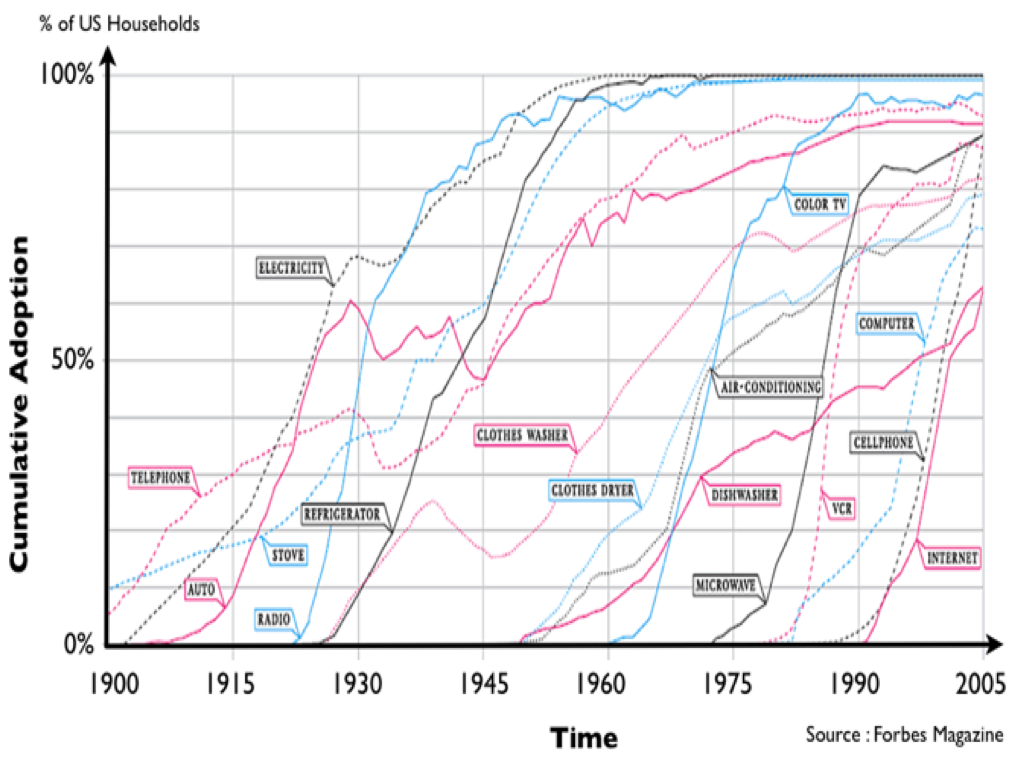
Recently I wrote an introductory blog post about the importance of VELOCITY as an innovation outcome. Today I want to drill a little deeper, to examine why velocity is so important to many businesses, and why innovation should be the technique that many turn to to accelerate velocity.
Few people would quibble with the argument that the pace of change is accelerating, and continues to accelerate. If, for example, you could teleport yourself to the Roman empire and examine the living conditions of the average family, you’d find that conditions weren’t overly improved for hundreds of years. New technologies were infrequent and scientific discovery was slow. Fast forward to the early Middle ages, as learning and communication improved, and we see an increasing pace of change. Comparing, say, the 1200s to the 1400s would demonstrate significant gains for the upper class in terms of products, services and technologies. But the pace of change for significant portions of the population was still slow. Consider even the 1950s and 1960s. Much of the world lacked basic infrastructure, communication systems, adequate food, while the “developed” world had all of these factors and more. Today, it’s not unusual to find people in depressed circumstances with access to cell phones, the internet, bank accounts and many of the trappings of a fully modern society. The pace of change has delivered more goods, services and technologies, and distributed them more quickly in the last few decades, than many believed possible.
Factors Driving Pace of Change
What factors drive the increasing pace of change? I’m sure better minds than mine have pondered this question, but a few factors seem relatively obvious. First, better information systems and communication systems. When communication is difficult, it is hard to transfer knowledge and information. As communications systems have advanced, the ability to spread information more broadly has improved the pace of change in many areas. Second, the distribution of education. Today, many of the world’s best universities are resident in the US, the UK, Germany and other “western” countries, but increasingly excellent universities are identified in India, China and other countries. Further, access to education, over the web, over the improved communication channels means that far more people can gain education and build skills. Third, the increasing demand for better living conditions, better lives for our children, more access to more things. Fatalism and the acceptance of a terrible life is a thing of the past. Everyone, everywhere demands a better standard of living, more access to more and better goods and services. These demands create the opportunity for a market, these demands are filled with new and better supply.
These are factors that I think are driving the increasing pace of change. But you don’t have to accept my assertions, you can see the increasing pace of change for yourself in adoption curves of technology. The “S” curves of technology adoption over the last 100 years demonstrate that it took years for a radio or television to penetrate many households, while newer products like VCRs, cell phone and PCs penetrated very quickly. One reason this is true is that the infrastructure (electricity, communication standards, interactivity) was built, deployed and stabilized. As the infrastructure got better, it became easier and easier to deploy and to use new technologies. See the increasing acceleration of adoption in the “S” curve image below.

Implications of Accelerating Change
The implications of this acceleration should be obvious – the pace of change and rate of acceleration is ever increasing. Individuals who were once satisfied with only one model of product are now more likely to be clamoring for more variety, more choice. This is something that even Henry Ford missed. Simply solving a basic transportation need led to ever increasing demands to satisfy comfort, status and ego needs. For many products and services, life expectancy is decreasing at the same rate as the accelerating pace of change. Few firms can count on long product cycle times.
Why this matters to Innovation
If these assumptions are true, then VELOCITY, as defined as speed in a specific direction, becomes very important for a firm’s ability to grow and compete. Relying on long product life cycles is not an option. Customers will demand new products, new features at an ever increasing rate. Firms can’t simply “dump” older technologies and products into “developing” markets because those market too understand the product/feature acceleration and reject older products. This acceleration means that firms must address the most significant barriers to velocity within their businesses. There are three barriers they must address:
- The ability to bring products to market very quickly. Most organizations have well-defined, stage-gate models that use waterfall approaches with many signoffs to reduce risk. These existing processes are long, drawn out affairs designed to prevent mistakes and perfect products rather than systems attuned to customer needs and expectations. One of the first activities many firms should undertake is to innovate their product development cycles.
- Few firms have invested in true innovation capabilities. Yes they have some “innovation” teams and perhaps even some systems or processes meant to sustain innovation, but they don’t consider innovation core to their business. Innovation – purposefully creating new, meaningful products and services that clients will want – will increase the organization’s speed, and potentially its velocity. It can increase velocity if…
- Executives create clear strategies based on the understanding of the importance of velocity. Innovation can result in more speed, based on improvements in the product development cycle time and in generating new ideas more effectively. But the difference between velocity and speed is intent. Velocity is speed in a specific direction. Executives must provide the demand for speed, combined with the insights that detail specific directions. Innovation needs far more attention from executives, in terms of greater importance and more clarity and focus.
Conclusion
So, hopefully you can see that perhaps the most important outcome innovation can deliver is velocity, that is, corporate speed with purpose. I’ve identified at least two areas where more internal speed is important, if a firm hopes to keep pace with its competitors and its market demands. Executives play an important role here as well. Our corporations become comfortable with our operating models and the internal pace of business. While our internal pace may be valuable, comfortable and well understood, our internal pace is irrelevant if the external pace of change is different. Far too many firms have too many structures that impede speed and velocity, and are too comfortable with a slow pace of change. Why they may believe they need innovation to create new products and services, these firms fail to realize how important it is to accelerate their operations and keep pace, at a minimum, with the market. And, not only is speed important, but velocity. Meaning that while we increase internal speed we do so in important, strategic directions.
In subsequent posts I’ll address the concept of innovation as a catalyst for corporate velocity.
Image credits: Pixabay, Forbes
![]() Sign up here to get Human-Centered Change & Innovation Weekly delivered to your inbox every week.
Sign up here to get Human-Centered Change & Innovation Weekly delivered to your inbox every week.

